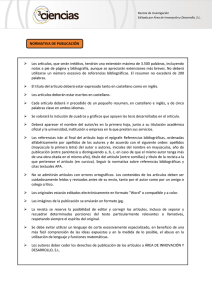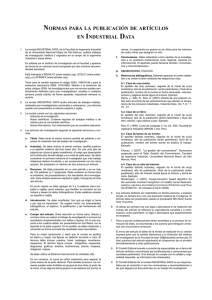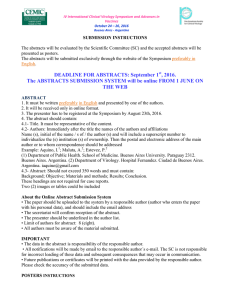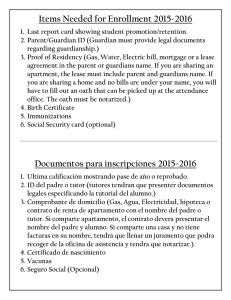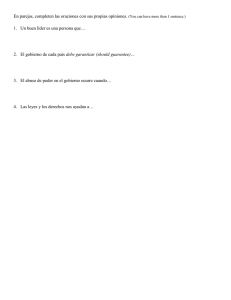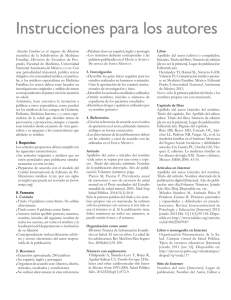Economia, gestion y desarrollo 4.pmd
Anuncio
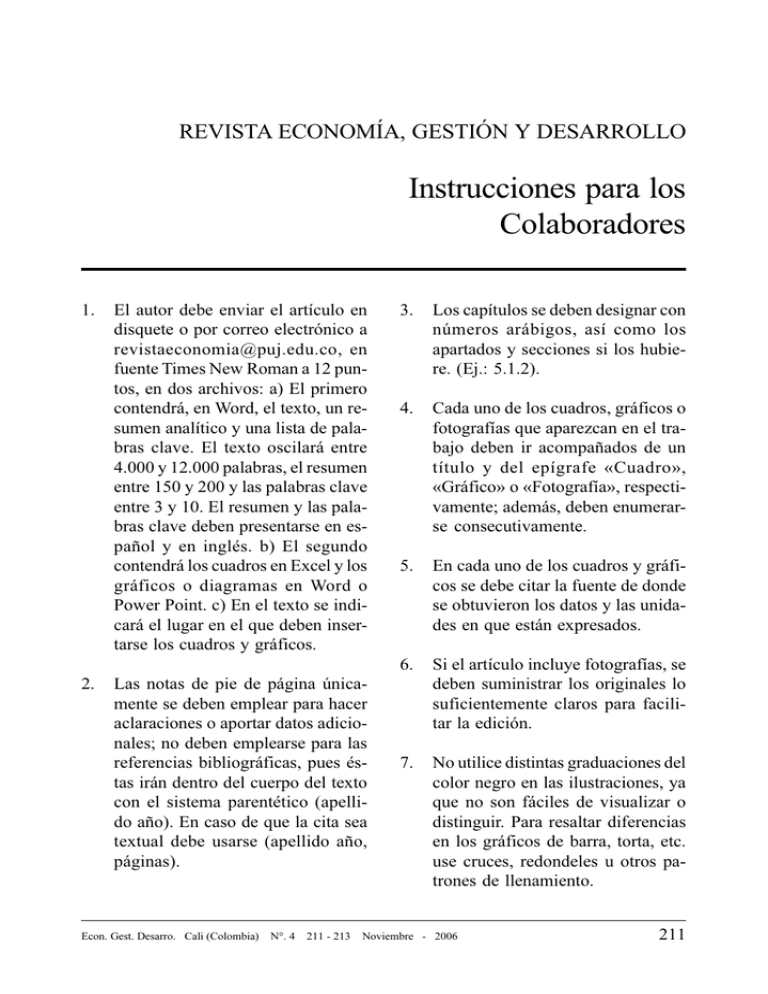
REVISTA ECONOMÍA, GESTIÓN Y DESARROLLO Instrucciones para los Colaboradores 1. 2. El autor debe enviar el artículo en disquete o por correo electrónico a revistaeconomia@puj.edu.co, en fuente Times New Roman a 12 puntos, en dos archivos: a) El primero contendrá, en Word, el texto, un resumen analítico y una lista de palabras clave. El texto oscilará entre 4.000 y 12.000 palabras, el resumen entre 150 y 200 y las palabras clave entre 3 y 10. El resumen y las palabras clave deben presentarse en español y en inglés. b) El segundo contendrá los cuadros en Excel y los gráficos o diagramas en Word o Power Point. c) En el texto se indicará el lugar en el que deben insertarse los cuadros y gráficos. Las notas de pie de página únicamente se deben emplear para hacer aclaraciones o aportar datos adicionales; no deben emplearse para las referencias bibliográficas, pues éstas irán dentro del cuerpo del texto con el sistema parentético (apellido año). En caso de que la cita sea textual debe usarse (apellido año, páginas). Econ. Gest. Desarro. Cali (Colombia) N°. 4 211 - 213 3. Los capítulos se deben designar con números arábigos, así como los apartados y secciones si los hubiere. (Ej.: 5.1.2). 4. Cada uno de los cuadros, gráficos o fotografías que aparezcan en el trabajo deben ir acompañados de un título y del epígrafe «Cuadro», «Gráfico» o «Fotografía», respectivamente; además, deben enumerarse consecutivamente. 5. En cada uno de los cuadros y gráficos se debe citar la fuente de donde se obtuvieron los datos y las unidades en que están expresados. 6. Si el artículo incluye fotografías, se deben suministrar los originales lo suficientemente claros para facilitar la edición. 7. No utilice distintas graduaciones del color negro en las ilustraciones, ya que no son fáciles de visualizar o distinguir. Para resaltar diferencias en los gráficos de barra, torta, etc. use cruces, redondeles u otros patrones de llenamiento. Noviembre - 2006 211 INSTRUCCIONES PARA LOS COLABORADORES 8. Los anexos deben ser puestos a continuación del final del texto de trabajo. Si hubiere más de un anexo anúncielos consecutivamente. • • 9. Las referencias bibliográficas completas deben ir en orden alfabético al final del artículo, con el siguiente formato: • Libros: Apellido, Iniciales del Nombre (año). Título. Ciudad: Editorial. Artículos de revista: Apellido, Iniciales del Nombre (año). «Título del artículo». Nombre de la revista, Vol. XX, Nº. XX, rango de páginas. Ensayos dentro de compilaciones o capítulos de libro: Apellido, Iniciales del Nombre (año). «Título del ensayo». Título del libro. Ciudad: Editorial. Ponencias: Apellido, Iniciales del Nombre (año). «Título de la ponencia». Congreso / Seminario XX. Ciudad. Fecha (mes y días). Recursos en línea: Autor. (año). Título de la página o de la publicación. [en línea]. Disponible en: dirección de la página [Consulta: mes día año] En todos los casos la palabra páginas se abreviará con pp. Y los rangos de páginas se indicarán con guión. Las referencias del (de los) mismo (s) autor (es) deberá (n) ser listadas por año en orden descendente. • • • • • • 212 • • Las referencias del (de los) mismo (s) autor (es) publicadas en un mismo año deberán ser listadas como a, b, c…, Ej.: 1997a, 1997b, etc. Las referencias del (los) mismo(s) autor(es) deberán repetir el (los) nombre(s) del (los) autores. No utilice una línea para representar los nombres. El año de publicación debe ser puesto entre paréntesis (1999). Si no hubiera información sobre la fecha, utilice (s.f.). Si estuviera en fase de edición, utilice (en imprenta). Para abreviar el estado de origen de editoriales norteamericanas, use la abreviatura postal de 2 dígitos (Por ejemplo, DC, IL, MA, NY, etc.). 10. En caso de contener fórmulas, éstas deben ir alineadas y numeradas consecutivamente al margen izquierdo. Para documentos de cierta elaboración matemática, se sugiere el envío de un anexo con derivaciones de las fórmulas. 11. Toda aclaración sobre el trabajo (agradecimientos, colaboradores, título del proyecto, entidad que lo financió, línea o grupo de investigación) se indicará con un asterisco en el título, remitiendo al pie de página. 12. El autor hará constar el número de clasificación del artículo según el Journal of Economic Literature Econ. Gest. Desarro. Cali (Colombia) N°. 4 211 - 213 Noviembre - 2006 INSTRUCCIONES PARA LOS COLABORADORES (JEL). Consultar el sistema de clasificación en http:// w w w. a e a w e b . o r g / j o u r n a l / jel_class_system.html. • 13. Información sobre los autores: • El artículo contendrá un archivo adicional con una breve hoja de vida del autor o de los autores, en el que se especifique: a) El título del trabajo, b) El nombre y apellidos del autor o de los autores (en el orden en que se desea que aparezcan). c) Los datos académicos del autor o de los autores (títulos de pregrados y posgrados, y las universidades que los otorgaron). d) Lugar de trabajo actual y cargo que desempeña. e) Dirección, ciudad, teléfonos y correo electrónico. 14. Condiciones para la publicación de los artículos • • • La Dirección de la revista acusará recibo de los trabajos enviados en un plazo no mayor de ocho días hábiles. En ningún caso se devolverán los originales. Economía, Gestión y Desarrollo supone que el material enviado es inédito y que, además, en caso de ser aceptado, no se publicará en otra revista salvo expresa autorización del Comité Editorial. El tema del artículo debe enmarcarse en las ciencias económicas, ad- Econ. Gest. Desarro. Cali (Colombia) N°. 4 211 - 213 • • ministrativas y contables, o en aportes relevantes a ellas hechos desde otras disciplinas. Se privilegiarán artículos que: a) sean producto de reflexiones teóricas originales; b) sean resultado de investigaciones empíricas con un claro referente teórico que las guíe; c) los que constituyan revisiones críticas sobre el estado del arte; tengan rigor metodológico. Economía, Gestión y Desarrollo es una revista arbitrada. Para su publicación, todo artículo será sometido a evaluación de pares anónimos; el concepto de dichos evaluadores se comunicará al (a los) autor (es), quien (es) deberá (n) atender sus observaciones. Los artículos recibidos serán remitidos al Comité Editorial, el cual tomará la decisión de enviarlos a los respectivos evaluadores y, posteriormente, con base en la evaluación de los pares decidirá sobre su publicación. Noviembre - 2006 213 214 JOURNAL «ECONOMÍA, GESTIÓN Y DESARROLLO» (ECONOMY, MANAGEMENT AND DEVELOPMENT) Instructions for Contributors 1. 2. The author should submit the article on diskette or by e-mail to revistaeconomia@puj.edu.co, in Times New Roman 12 pt, in two files: a) the first will contain (in Word) an analytical abstract of the text and a list of key words. The text will range between 4,000 and 12,000 words, the abstract between 150 and 200, and the key words between 3 and 10. The abstract and key words should appear in English and Spanish, b) the second should show the tables in Excel and the graphics and diagrams in Word or Power Point, and c) The text will also clearly show the points at which the tables should be inserted. Footnotes should only be used for making clarifications or giving additional information; they should not be used for bibliographical references, because these should be found in the body of the text using parenthesis system (last name, year). If the quotation is textual the «last name, year, page number» style should be used. Econ. Gest. Desarro. Cali (Colombia) N°. 4 215 - 217 3. The chapters should be written in Arabic numerals, together with paragraphs and sections, if there are any. (eg.:5.1.2). 4. Each of the tables, graphs or photographs that appear in the document should be accompanied by its title and the heading «table», «graph», or «photograph» respectively. They should also be numbered consecutively. 5. In each of the tables and graphs, the source from which the information was obtained, and the units in which it can be found, should be quoted. 6. If the article has photographs, originals of these should be supplied which are sufficiently clear to allow publication. 7. Do not use different tones of black in illustrations, since these are not easy to see or distinguish. To highlight differences in bar graphs, pie charts, etc., use crosses, rings or other fill-in patterns. Noviembre - 2006 215 INSTRUCTIONS FOR CONTRIBUTORS 8. 9. • • • • • • • • 216 Appendices must be placed at the end of the text. If there is more than one appendix, these should be shown consecutively. Complete bibliographical references must be shown in alphabetical order at the end of the article, in the following format: Books: last name, first name initials (year). Title. City: Publisher Journal Articles: last name, initials of first name, (year) «Title of Article», Name of journal, Vol XX, Nº. XX, relevant pages. Essays as part of compilations or book chapters. Last name, first name initials (year). «Title of Essay», «Title of Book». City: Publisher. Papers: Last name, first name initials (year) «Title of Paper». Name of Congress/Seminar. City. Date (month and days). On-line Resources: Last names, first name initials (year). Page or publication title (on line). Available at: page site (consultation: month, day, year). In all cases the word «pages» should be abbreviated as «pp», and the range of pages shown with a hyphen. References to the same author(s) must be listed by year in descending order. References to the same author(s) published in the same year must be listed as «a.b.c….» eg. 1997a, 1997b, etc». • • • References to the same authors must repeat the author’s(s’) name(s). Do not use one line to show the names. The year of publication should be shown in parenthesis (1999). If there is no information about the date, use (n.d.). If the document is in the process of edition, use «in press». To abbreviate the state of origin of North American publishers, the postal two-digit abbreviation should be used (eg. DC, IL, MA, NY, etc). 10. If formulas are involved, these must be aligned and consecutively numbered in the left-hand margin. With certain types of mathematical presentations we suggest you include these on a separate (non-publishable) attachment or addendum with the appropriate derivations of the formulas for the benefit of the Editorial Committee. 11. Clarification regarding the work (acknowledgments, collaboration, project title, financing entity, research line or group) shall be shown with an asterisk in the title, referring to the footnote. 12. The author will write the classification number of the article according to the Economic Literature Journal (ELJ). Consult the classification system at http:// w w w. a e a w e b . o r g / j o u r n a l / jel_class_system.html. Econ. Gest. Desarro. Cali (Colombia) N°. 4 215 - 217 Noviembre - 2006 INSTRUCTIONS FOR CONTRIBUTORS 13. Information about the authors • • The article must contain an additional file with a brief curriculum vitae of the author or authors. This will state: a) the title of the work, b) the name and surname of the authors, in the order in which they are required to appear, c) academic information about the author or authors (undergraduate or postgraduate courses, and universities from which they were obtained), d) their current place of work and the position held, e) address, city, telephone numbers and e-mail address. It must be stated whether the article is the product of a research activity, thesis, essay or a critical review. If it was part of a research activity, the following information must be given: project title, the organization that financed it, and the date on which it was carried out. published in any other journal without the specific permission of the Editors’ Committee. • The subject of the article should come within the scope of the economic, administrative or accounting sciences, or represent contributions to these sciences from other disciplines. • Articles will be preferred which: a) are a product of original theoretical thought, b) are a result of personal experience guided by clear theoretical principles, c) consist of critical state-of-the-art reviews, and demonstrate methodological correctness. • Economía, Gestión y Desarrollo, is a journal with external controls. Every article submitted for publication will be sent for evaluation to anonymous peers, whose observations must be acted upon by the author or authors • Articles received will be referred to the Editorial Committee, which will decide whether to send them to the respective evaluators, and then, based on the observations of the peers, will take a decision on their publication. 14. Publication of articles – conditions • The editor of the journal will acknowledge receipt of papers sent, no later than eight working days after their arrival. Under no circumstances will originals be returned. • Economía, Gestión y Desarrollo assumes that the material submitted has not been edited, and that, after having been accepted, may not be Econ. Gest. Desarro. Cali (Colombia) N°. 4 215 - 217 Noviembre - 2006 217
